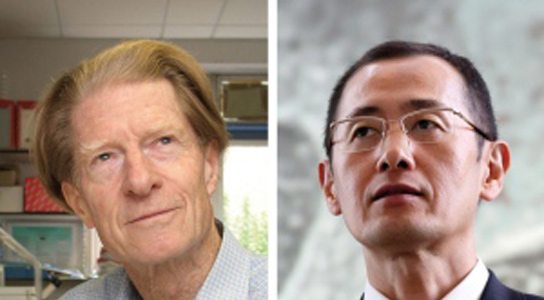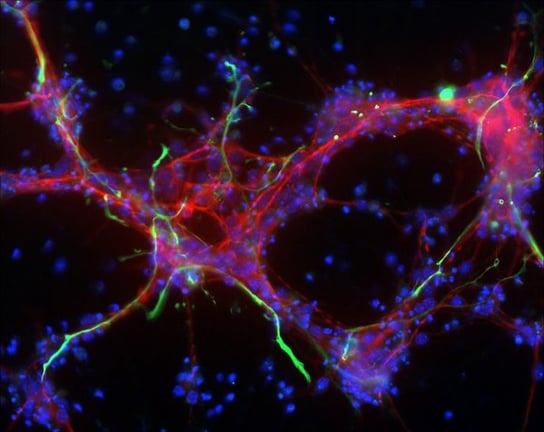Medicine Nobel Prize Awarded to Researchers for Reprogramming Mature Cells to a Pluripotent State
October 9, 2012

John Gurdon (left) and Shinya Yamanaka showed how to reprogram cells into their embryonic states.
The discovery that mature, adult cells can be reprogrammed back to an embryonic-like state has won this year’s Nobel Prize in Physiology or Medicine. It was awarded to two pioneers of stem-cell research, John Gurdon and Shinya Yamanaka.
Reprogrammed cells are able to regain pluripotency, the potential to differentiate into many mature cell types. Researchers hope that these cells will eventually be used in regenerative medicine, providing replacement tissue for damaged or diseased organs.

Human induced pluripotent stem cells that have been turned into human nerve cells (red). The technique, which won this year’s Nobel Prize in Medicine, allows scientists to make stem cells from skin cells. (Bruce Conklin/Gladstone Institutes)
Gurdon is based at the Gurdon Institute in Cambridge, UK, and was the first person to demonstrate that cells could be reprogrammed 50 years ago. At that time, researchers thought that cellular specialization was a one-way process and that it couldn’t be reversed. Gurdon was able to prove the opposite, by removing the nucleus from a frog egg cell and replacing it with the nucleus from a tadpole’s intestinal cell. This process was also able to turn back the clock of the substitute nucleus. Even though it had already committed itself to specialization, inside the egg cell, it was able to act like an egg’s nucleus and direct the development of a normal tadpole.
Mammalian cells didn’t prove as amenable to this process as frog cells. This technique is known as cloning by nuclear transfer and it took nearly 35 years before the first cloned animal, Dolly the sheep, was born in 1996.
Shinya Yamanaka of Kyoto University, Japan, used cultured mouse cells to identify the genes that kept embryonic cells immature. Then, he tested whether any of these genes could reprogram mature cells to make them pluripotent.
In the mid-2000s, Yamanaka was close to this feat. A few months after the 2006 meeting of the International Society for Stem Cell Research in Toronto, Canada, Yamanaka announced his surprisingly simple recipe to complete his task. The activation of only four genes was enough to turn adult fibroblast cells back into pluripotent stem cells. Such induced pluripotency would allow the cells to be coaxed into different types of mature cells, including nerve and heart cells.
Both scientists state that translating these discoveries into regenerative therapies will take time, which is why it’s important for people to support it.
No comments:
Post a Comment